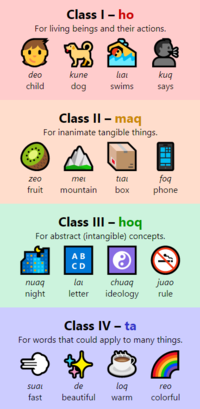Animacy: Difference between revisions
| Line 13: | Line 13: | ||
{| class="wikitable" | {| class="wikitable" | ||
|+ Toaq animacy classes | |+ Toaq animacy classes | ||
! Nr. !! Class !! Pronoun !! Example | ! Nr. !! Class !! Pronoun !! Example !! Meaning | ||
|- | |- | ||
| 0 || ({{t|raı}} alone) || ({{t|ráı}}) || {{t|sa rảı}} | | 0 || ({{t|raı}} alone) || ({{t|ráı}}) || {{t|sa rảı}} || something | ||
|- | |- | ||
| I || Animate verbs || {{t|hó}} || {{t|sa pỏq}} | | I || Animate verbs || {{t|hó}} || {{t|sa pỏq}} || a person | ||
|- | |- | ||
| II || Inanimate verbs || {{t|máq}} || {{t|sa jỉo}} | | II || Inanimate verbs || {{t|máq}} || {{t|sa jỉo}} || a building | ||
|- | |- | ||
| III || Abstract verbs || {{t|hóq}} || {{t|sa sỉo}} | | III || Abstract verbs || {{t|hóq}} || {{t|sa sỉo}} || an idea | ||
|- | |- | ||
| IV || Adjective verbs || {{t|tá}} || {{t|sa dẻ}} | | IV || Adjective verbs || {{t|tá}} || {{t|sa dẻ}} || something pretty | ||
|- | |- | ||
| V || {{tone|5}} clauses || {{t|róu}} || {{t|dûa jí sıa rảı}} | | V || {{tone|5}} clauses || {{t|róu}} || {{t|dûa jí sıa rảı}} || that I know nothing | ||
|- | |- | ||
| VI || {{t|lu}} phrases || {{t|kúy}} || {{t|lú tảo jí hóa}} | | VI || {{t|lu}} phrases || {{t|kúy}} || {{t|lú tảo jí hóa}} || what I do | ||
|- | |- | ||
| VII || {{t|po}} phrases || {{t|zé}} || {{t|pó sa gỉ}} | | VII || {{t|po}} phrases || {{t|zé}} || {{t|pó sa gỉ}} || a good one's | ||
|- | |- | ||
| VIII || Personal pronouns || {{t|fúy}} || {{t|nháo}} | | VIII || Personal pronouns || {{t|fúy}} || {{t|nháo}} || they | ||
|- | |- | ||
| IX || Demonstratives || {{t|bóu}} || {{t|ní}} | | IX || Demonstratives || {{t|bóu}} || {{t|ní}} || this | ||
|} | |} | ||
Revision as of 16:02, 6 February 2022
Toaq has a system of grammatical animacy.
Any noun phrase belongs to one of nine classes, each with its own word for “he/she/they/it” that refers back to the most recent noun phrase belonging to that class. (This system of anaphoric pronouns is the only place in Toaq where this animacy distinction comes up, so the classes are known varyingly as animacy classes, anaphora classes, or pronominal classes.)
Grammatical, rather than natural animacy
Toaq's animacy being "grammatical" means that it is a property of expressions, not of their referents.
If you know some Spanish, it's like "grammatical gender" in that language. La persona is feminine, even if the person you're talking about isn't necessarily female.
Toaq's pronouns work the same way: if you describe a person as sa sảo (“someone big”), the appropriate pronoun to refer to them later in the sentence is tá (“itadj.”), because sảo is an adjective. It's not correct to use hó, because that's the pronoun for animate verbs, not animate referents.
Table of classes
Note the following distinction:
- Classes V through IX apply when the expression has a certain grammatical form.
- Classes 0 through IV apply depending on the "main" verb animacy class of a determiner phrase.
Verb animacy classes
Every Toaq verb belongs to some verb animacy class:
- If the verb is raı, it's in class 0 (the class containing only raı).
- If the verb necessarily implies animacy/sentience of its subject, it's in class I (hó).
- Examples: poq, naq, kato, che, be, deo, mıe, koı, moı, tao, fıeq, jaı…
- If the verb describes some other tangible object, it's in class II (máq).
- Examples: cea, kıoq, haq, toq, nao, hoe…
- If the verb describe an abstract concept or idea, it's in class III (hóq).
- Examples: noı, daq, dao, sıo, muı, zu…
- Other verbs are in class IV (tá).
- Examples: doq, nuı, juı, lıo, muo, raq, daı, de…
Which is the "main" class?
How do we determine the animacy class of a DP like sa dẻ pỏq — a serial of a class-IV and a class-I word?
An unofficially proposed rule seems to boil down to: "use the first non-class-IV word's class, if possible; otherwise use class IV".
